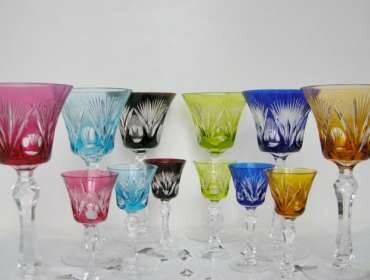However, not everyone knows that in addition to the traditional transparent, there is still an unusually beautiful and spectacular colored crystal, which is obtained through the addition of various metal oxides into the glass. They give the crystal unusually noble shades of red, purple, blue, green and pink colors.
Each color is obtained by using a certain additive. For example, cobalt gives pure blue tones, cadmium or gold compounds create a red color, silicon is pink, copper makes it green, and manganese is purple.
Different manufacturers by choosing the ratio of additives achieve unique brand tints. Some factories in the eighteenth and nineteenth centuries dyed their crystal with colloidal gold and uranium oxides. These were the most expensive and most artistic items.
The production of crystal is a difficult and time-consuming process. First, it is necessary to melt the charge from which the crystal is made. Charge material is a mixture of sand, potash and lead oxide, the presence of the latter is the main difference between crystal and plain glass. Before proceeding creating a future product, the master accurately measures the weight of each ingredient, accurate to a milligram, then everything is mixed and sent to the oven. The raw material melts in furnaces at a huge temperature above 1500 degrees Celsius, and since the molten mass cools very quickly, several people are engaged in one product to accelerate the process.
The future colored crystal is melted in a special oven; the desired shape (more often a ball) is blown out of it using a tube, and again put back into the oven. To make a ready product there should a four people team with good coordination. After a first shape of product is made it’s placed into annealing oven.
In annealing oven the process of “hardening” of glass slows. In annealing oven temperature falls from 700 to 45 degrees. After such heat treatment, ordinary glass becomes heat-resistant and durable. Then, in the flame of the gas burner, the upper part of the product is cut off. After that, the product passes the first quality control: whether there are large bubbles, stones, curvature; measuring the thickness of the glass layer.
Usually a crystal product is decorated with engraving - a shallow matte pattern, a wide polished face with a facet, and deep grooves in the carving, which form so called "diamond face". The process of applying a diamond face begins with the marking, and then with the help of abrasive circles, the very face is applied, starting with the largest abrasive circle and ending with the smallest ones. To prevent glass dust from entering the respiratory tract, water is supplied to abrasive circles. After application, the diamond face becomes opaque to obtain a transparent face; the product is polished.
Grinding is the process of removing a layer of crystal by means of mechanical influences with a special abrasive tool or with the application of abrasive materials. First of all, the edge of the product and the bottom (dressing) are subjected to grinding.
Finally the product is polished with acids that help to obtain a good "transparency" and a greater gloss.
Upon completion of the polishing process, the product is thoroughly washed and after that the crystal faces, having acquired a special luster, refract light and create bright rainbow reflections. In conclusion, if necessary, the face is applied to the product, which must remain opaque.


